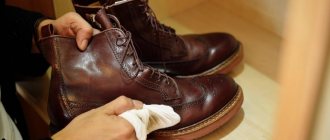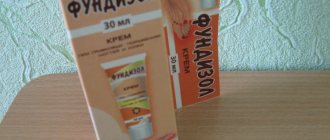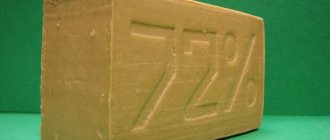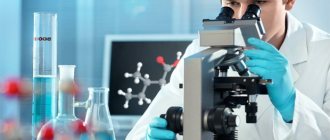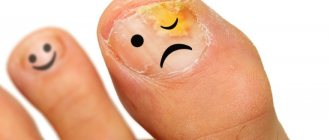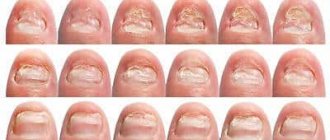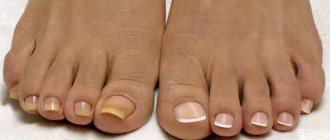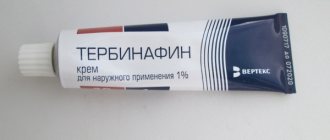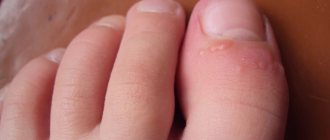What is nail fungus?
Fungal infection of the nail plate is called onychomycosis. This is an extremely common disease that is diagnosed in people of any age, including children. The pathological process is caused by the active proliferation of infections on the feet and hands, which leads to yellowing, delamination, changes in the structure of the nail, as well as damage to the skin tissue around it.
The disease is classified depending on its pronounced manifestations:
- onycholytic – characterized by damage to the nail plate and its rejection from the nail bed;
- hypertrophic, in which the plate loses its glossy shine, turns pale, turns yellow, darkens, and also changes its structure: it thickens, becomes deformed, and collapses at the edges;
- normotrophic, when a seemingly healthy nail plate becomes covered with small spots;
- total, in which the entire nail is affected;
- distal, when the lesion is located only at the edge.
It is very easy to become infected with onychomycosis. Pathogens are transmitted from a sick person, as well as through the things he uses.
Increase the likelihood of infection:
- weak immunity;
- violation of the integrity of the skin and nails;
- vascular diseases;
- wearing low-quality, tight shoes;
- failure to comply with personal hygiene rules;
- severe stress.
If signs of illness occur, you should consult a dermatologist or mycologist. The sooner therapy is carried out, the faster it will be possible to cope with mycosis.
How to test for fungi
In case of a fungal infection of the nails, material is taken for further research in the laboratory. For examinations, a small part of the nail plate and the skin next to it is sufficient. This manipulation is performed only in medical institutions by a dermatovenerologist. To collect material, use a scalpel, needle or scissors. Sometimes a sterile spatula is suitable if the nail is very crumbly. The biological substrate is taken from the places where the fungus had the strongest impact. To detect fungal spores, scales are collected using a spatula. The material is placed in a test tube with saline solution or a special container. Solid particles are dissolved in special substances. Then everything is sent to the laboratory department for further research. The procedure for collecting biomaterial is completely painless and is performed by a highly qualified specialist. To cure mycosis, the best option is to see a doctor early and get tested. Then effective therapy is possible, it will completely eliminate the disease.
When should you get tested?
A fungal infection manifests itself differently in everyone. In more sensitive people, itching and burning immediately begins in the affected area, and redness of the skin appears. If you continue to ignore the unpleasant symptoms and do not test the nail for fungus before therapy, the plates become deformed, thicken, become covered with longitudinal or transverse grooves and stripes, take on an unpleasant hue, and emit a putrid odor.
Further:
- folds in the interdigital area crack;
- thickenings appear on the skin;
- severe, painful itching and burning appears;
- the nail becomes very fragile and brittle.
When the first signs of pathology appear, you will need to conduct an analysis for the presence of fungus on the nails.
Testing is also necessary when:
- the dermatologist doubts the diagnosis;
- the treatment, which may take a long time, does not give positive results, and the disease progresses;
- the course of treatment has ended, but there are doubts about the complete destruction of the infection;
- clinical manifestations of the fungus are still observed, although in a blurred form;
- the infection became chronic.
Diagnosis is required after therapy is completed.
Important! Clinical testing of biological material is prescribed to identify infections in the body. If fungal flora is present, systemic treatment is prescribed, since the use of external agents alone will be ineffective.
Where can I get tested?
A dermatologist, when referring a patient for diagnosis, always tells him where to get tested for nail fungus. If a person is not suitable for the institution to which he is referred, he can be examined in another private laboratory, clinic or mycological center that provides similar services.
General and clinical blood parameters can be checked in a public or private clinic. You can also submit urine collected at home the day before for examination.
Preparing for analysis
Having decided on the problem, where the necessary tests can be taken and knowing the price of services, the patient needs to find out how the procedure goes and how to properly prepare for it.
Often the examination takes place in stages:
- the scraping is examined under a microscope;
- bacterial culture is carried out;
- do a PCR test;
- hemotest.
The biomaterial for study is particles of the affected nail and venous blood.
A scraping for nail fungus will be as informative as possible if you follow these recommendations before going to the laboratory:
- do not wash the affected areas with soap or other cosmetic detergents for three days before the test;
- do not use antifungal drugs during the same time;
- do not drink strong tea or coffee drinks 6 hours before testing;
- 10 days before the examination, do not cut your nails;
- remove decorative and medicinal varnish from the nail surface;
- Do not wet your hands/feet 4 hours before the test.
When taking a blood test for fungus, you need to consider that:
- 8 hours before testing you should not eat;
- do not drink alcohol for 48 hours;
- do not overwork and avoid severe stress;
- do not smoke before taking blood.
You also need to tell the laboratory assistant what medications the person is taking. You may have to stop taking some medications the day before.
Types of blood tests
Having discovered changes on the nail plates, you should find out their origin, which helps to analyze the nail for fungus.
Diagnostics includes several types of tests:
- PCR test (polymerase chain reaction);
- clinical and biochemical test of venous blood or urine.
Venous blood is collected in the manipulation room. The laboratory technician puts on sterile gloves and uses a vacuum tube with patient information labeled on it. Tubes with collected blood are sent to the laboratory for careful examination and evaluation of indicators.
Important! Diagnostic procedures should not be postponed for a long time, since fungal infection is extremely contagious and is characterized by rapid progression. It is transmitted through household contact and has a high index of contagiousness.
Bacteriological culture
By taking a bacteriological test to determine nail fungus using the culture method, you can determine the causative agent of onychomycosis. The laboratory assistant collects the necessary biomaterial and places it in a nutrient medium in which microbes begin to multiply intensively. The growth of pathogenic flora is maintained by a thermostat at a comfortable temperature for it. Fungal colonies grow within 3-14 days.
There are negative factors that affect the reliability of the survey:
- type of collected biomaterial. Fungi are rarely detected in the blood. They are mainly localized in scrapings from the affected plate;
- use of fungicidal oral medications on the eve of the examination. In this case, the analysis will give a false result.
Polymerase chain reaction
This is the most reliable nail fungus test, allowing you to identify the pathogens that cause the development of onychomycosis:
- Any biomaterial is suitable for the test;
- using this reaction, you can determine the DNA of the pathogen and identify its type;
- get reliable results within five hours after taking the test;
- the ability to detect even single pathogenic particles.
Despite its many advantages, the PCR method can give false results. This mainly happens when particles of an already destroyed pathogen are detected.
Hemotest
This is an assessment of blood parameters for the compatibility of foods with the body. Allowed foods should be included in a person’s menu, and junk food should be avoided or its consumption reduced to a minimum.
Testing is carried out after taking antifungal medications, when the mycosis has been completely overcome. This diagnostic procedure is considered an excellent prevention of both fungal and other diseases.
Urine examination
The urine of a healthy person should not contain fungal infections. Their identification means that a malfunction has occurred in the body, and the patient requires systemic treatment.
Laboratory methods can detect the following types of fungus in urine:
- moldy;
- yeast;
- radiant;
- candida.
To conduct tests for fungus, you must bring morning urine to the laboratory in a sterile container designed for this purpose.
Causes of false positive fungal tests
Errors in analysis results do occur. There are a number of factors for the appearance of a false positive conclusion for the fungus. For example, a person did not properly prepare for collecting material. The result of the analysis will be inaccurate, quite possibly a false positive. A lot depends on the laboratory. Collection of biomaterial should be carried out only with a sterile instrument. The test tube must be original and the packaging must be intact. If one of these items is contaminated with fungi, the test result will certainly be a false positive. The reliability of the research procedure depends on the laboratory assistant. Hands must be wearing sterile gloves. This will prevent contamination of biological material. If you do not violate the procedure for preparing for analysis, there should be no erroneous results. It is better to contact a trusted specialist or a specialized laboratory.
Nail analysis
In case of external damage to the nail plate at any stage of the disease, analyzed for fungus:
- microscopy of scrapings (approximate price 600 rubles);
- sowing the fungus for nutritious flora (approximate cost 1550 rubles).
Test for mycosis
When learning how to get tested for nail fungus, you need to find out what material is used. Its careful examination will help determine the infection that affects the plates.
The test for mycosis is carried out as follows:
- Before figuring out how to get tested for nail fungus, the patient should see a dermatologist. The doctor examines the damaged nails and decides whether further diagnostics are needed. Sometimes an initial examination is enough to understand how advanced the pathology is and what drugs are needed to combat it;
- First, the plate is scraped to determine the etymology of the pathogen;
- then bacteriological culture is used to determine the degree of sensitivity of pathogens to antimycotics;
- Based on the results of the research, the specialist determines treatment tactics, which may include taking tablets, using creams, ointments, fungicidal varnishes, and folk remedies.
What is tank seeding?
Nail particles affected by the fungus are placed in a nutrient medium, where colonies of the pathogen begin to actively grow. At the same time, the resistance of the crop to fungicidal substances included in all antimicrobial preparations is determined. The resulting infections are treated with a certain type of drug and see how they react.
It is not advisable to prescribe fungicidal agents without this test, since other dermatological ailments affecting the skin of the hands and feet have similar clinical symptoms: eczema, vitamin deficiency, intoxication, etc. Also, the nail could be severely injured, and an infection could penetrate into the wound, causing severe swelling, redness and suppuration. In this case, antimycotics will not provide a therapeutic effect, but will only worsen the situation.
How is scraping performed?
The sample is taken with a medical spatula, with which the top layer is removed along the furrows or under the nail folds. Biomaterial is also collected under the nail itself. If a small part of the plate is affected, toenail and fingernail fungus is identified by scraping. If the lesion is large, cut off a piece of the nail.
Does scraping hurt?
Patients who are scheduled to have their nails tested for fungus by scraping are interested in whether the procedure is painful. Taking biomaterial this way does not hurt. The test is quick and painless. The resulting material is sent for bacteriological culture, which determines the presence of pathogenic flora.
What does the analysis show?
If a nail fungus test is carried out with blood donation, this is done so that the specialist can understand:
- whether inflammation occurs in the body;
- what stage is the pathological process at?
A biochemical examination shows the condition of the internal organs: liver, pancreas, kidneys. After all, fungi can affect not only the skin and nails, but also important systems of the body, gradually destroying and poisoning them. The pathological process negatively affects the mucous membranes, joints, ligaments, and bone tissue. In addition, this way you can determine which drug should be prescribed: local or oral.
Fungicidal drugs are processed by the liver, excreted by the kidneys and put a strain on the pancreas. To prevent drug therapy from aggravating their effects, it is necessary to conduct a blood test for the fungus. Microbiological examinations of the nail plate itself help to identify the pathogen and determine its sensitivity to drugs.
It is also recommended that the patient donate blood for culture. Normally, it should be sterile, without the presence of fungal flora. If a generalized fungal infection develops, elements of the pathogen are found in the bloodstream, and on the legs and arms the fungus will only be a symptom of the general pathological process. A clinical blood test is required both at the beginning and at the end of the therapeutic course, which helps to monitor treatment measures and determine the degree of their effectiveness.
A dermatologist explains how to get tested for nail fungus. He tells the patient how long the test takes and what specific tests will need to be performed. If a person does not remember what the test for fungal pathogens is called, they will be helped in the laboratory. There you can find out how much the procedure costs and when the results will be ready.
How is the procedure performed?
Let's figure out how to get tested for fungus correctly. Preparing for the procedure is not difficult, but you need to know some nuances so as not to get distorted results.
General clinical studies
You have to donate blood and urine for general clinical examinations quite often. But still, it would not be superfluous to remind you how to prepare for such a study. Analysis of urine:
- one day before the delivery time, you should avoid taking vitamin-mineral complexes, alcoholic beverages, and herbal preparations;
- the day before you should not visit the bathhouse or sauna; significant physical activity should be avoided;
- You need to take a morning sample of urine for analysis, as it is more concentrated;
- to collect urine, you can buy a special sterile container at the pharmacy or use any suitable container with a wide neck, which must first be thoroughly washed and dried;
- before the procedure, you need to thoroughly clean the external genitalia;
- For the examination, you need to collect an average portion of urine, that is, you first need to urinate a little in the toilet, and then collect about 100 ml of urine in a container.
Advice! It is important that when collecting material the container does not touch the skin.
Blood analysis:
- one day before collecting the material, you need to exclude fatty, spicy foods, and alcohol from your diet;
- The test is taken in the morning, on an empty stomach, and you are allowed to drink some clean water. Tea, coffee - not allowed;
- do not smoke for at least one hour before collection;
- blood is taken from a vein using a disposable instrument.
Collection of biomaterial for microbiological examinations
To identify the type of causative agent of onychomycosis, material is collected from the affected nail. This may be a scraping from the nail or a piece of the nail. The procedure is absolutely painless and safe. To make a scraping, a specialist uses a sterile spatula, which carefully removes the top layer from the nail plates.
Advice! The dermatologist decides after an external examination which type of examination should be prescribed - scraping or cutting the overgrown edge of the nail.
Usually:
- if the affected area is small, scraping is performed;
- if the lesion is located on the outer edge of the plate, then it is easier to cut off a piece of the nail;
- if the process also affects the nail fold, then scraping is prescribed.
The collected material is placed in a sterile container and sent to the laboratory. Preparation for collecting material for research is carried out as follows:
- For two days, you cannot wash the affected limb using detergents (you can just rinse with water);
- it is prohibited to use creams, lotions and other cosmetics in the affected area;
- the nail should not be varnished, neither decorative nor medicinal products should be used;
- do not take medications that may affect the test results.
Advice! Tell the doctor who refers you for testing what medications you are taking. You may need to take a break from taking some medications.
Can I do the test at home?
If it is not possible to carry out diagnostics in the laboratory, you can do an analysis for the presence of fungus at home:
- prepare a pink solution of potassium permanganate;
- put your feet or hands in it for three minutes;
- wipe the limb thoroughly;
- examine the nail plates: if they are yellowed, then there is no fungal infection. If the color of the nails has not changed, then this is a sign of developing onychomycosis.
With such a test it is impossible to determine the type of pathogen, but it is quite possible to suggest a diagnosis. Therefore, visiting a dermatologist and conducting a laboratory examination should not be postponed.
Some patients don't like going to hospitals. The reason for this is the lack of free time and long waits outside the offices. Also, few people want to voice their problem, because it is still believed that only unscrupulous people can get fungus on their nails. To make the examination as comfortable as possible, some private medical centers offer testing at home. A person will not need to waste time traveling and will not have to wait for his turn. Specialists come to your home, collect material, and send the result by mail.
If changes appear on the nail plate, it has lost its healthy shine, is covered with cracks, spots, or has changed color, then this may be a sign of a fungal infection or onychomycosis. When contacting a specialist, the patient is referred for an examination, which should not be refused. Using the results obtained, you can make an accurate diagnosis and determine what medications you need to use.
results
The collected material is sent for research. A simple test will detect the presence of a fungal infection. And in order to determine the type of pathogen and its sensitivity to drugs, a PCR study is carried out and bacterial culture is performed.
Bakposev
To determine the type of pathogen, the material is planted on nutrient media. Then they are placed in conditions favorable for the fungus for five days. During this time, the growth of colonies of the fungus occurs, by the appearance of which the type of pathogen can be easily determined. To determine sensitivity to antimycotics, perform the following steps:
- discs made of hygroscopic material are impregnated with solutions of various medicines;
- discs are applied to the grown colonies of fungi;
- after some time, assess how effectively the drug suppresses the growth of the fungus.
Advice! Starting to treat fungal nail disease without conducting examinations and tests is a gross mistake. The fact is that other dermatological diseases may have similar symptoms. In particular, psoriasis or eczema. To treat these diseases, completely different means are needed, so antifungal therapy will only do harm.
PCR diagnostics
At the moment, this examination has the greatest accuracy. At the initial stages of the disease, other research methods can give a negative result, but PCR can give the correct result, regardless of the stage of the disease.
The technique is based on analysis of the DNA structure, so the study will not only detect the presence of infection, but will also accurately determine the type of pathogen. In addition, the examination allows you to determine the concentration of the pathogen. Diagnosis of PCR is made by testing blood and scraping from the diseased nail.

